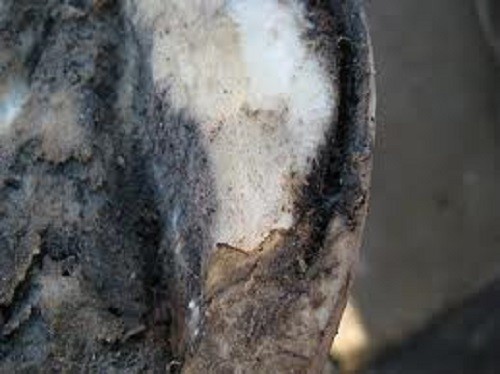My most recent blog post explains my goal to convey the anatomical equine hoof and the several functions of each part in a breakdown format. I believe it is essential to thoroughly understand the how’s and why’s of the horse in order to truly find the advantages to maintaining a barefoot furry friend. Assuming readers have an understanding of the basic features of the hoof and lower limb, I would like to communicate these lessons at an intermediate level. It is simple to refer to other sources to establish the basic knowledge of certain key points, if need be.
The “white line” is a feature consistently referred to in conversation regarding hooves and we have all heard or worse yet, experienced, white line disease. This bit of the hoof is fairly easy to identify, but what is it?

Photo provided by http://www.equipodiatry.com/wld.htm
When observing the hoof from a solar view, many hooves will display what appears to be two “lines” that border the sole of the hoof. The white line is inferior and located closer to the sole and often appears more golden rather than white. The given name in the 1800’s for this particular anatomical feature was the “golden line”. This point of interest characterizes the junction of the pedal bone to the hoof wall by dermal and epidermal laminae.
Epidermal laminae are more commonly termed as the hoof wall and they surround the internal structures. During formation of the hoof, dermal laminae are highly vascular before they are keratinized and developed into their secondary form, epidermal laminae (also named the hoof wall, as mentioned), much like how fingernails grow distally from the nail root. The white line simply symbolizes the point at which the convergence from primary to secondary laminae occurs; where the keratinization from soft tissue to dense tissue takes place.
In addition, the white line is famous for its named-after trim utilized by Pete Ramey. The “white line trim” is plainly called so because the trim focuses on improving the laminae of the hoof, most crucially in a horse diagnosed with laminitis. The inflammation of the dermal tissues cause the white line to stretch and expand, resulting in a flared hoof capsule. As the hoof continues to flare, the ground forces the white line to stretch further and further (often called peripheral loading). Meanwhile, the primary laminae are pulled away from the pedal bone causing soreness of all degrees.

Photo acquired from The Bootmeister’s blog, “Winter Leaving It’s Mark”
In order to correct this issue, permitting that the sole of the horse can withstand weight, pressure must be removed from the hoof walls and the center of the hoof should be bearing the majority of the weight. What can EasyCare offer for a horse with white line troubles? Comfort pads available in three different densities can be altered to custom fit the sole of hoof and relieve pressure from the white line. Depending on hoof dimensions, one of our experienced customer service representatives can recommend the best boot for the horse with special concern to the severity of the condition. EasyCare recommends consulting your hoof care practitioner or veterinarian before rehabilitating your horse on your own.
Mariah Reeves

Customer Service
As one of the customer service representatives, I am happy to help get your horse into the right boots. I promote holistic methods of equine care and will assist you with finding the perfect fit for horse and rider.




